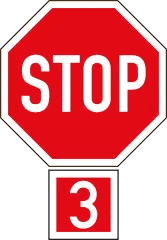Back to Regulatory Signs signs

3-Way Stop Sign: Rules, Right-of-Way, and How to Navigate Safely
Regulatory Signs
A 3-way stop sign regulates traffic at T-intersections where three roads meet. All drivers must come to a complete stop, but right-of-way rules differ slightly from 4-way stops.
How Does a 3-Way Stop Work?
At a 3-way stop, drivers follow these steps:
- Stop Completely:
- Halt at the white line or before entering the intersection.
- Rolling stops are illegal and risk fines.
- Identify Right-of-Way:
- First to stop = first to go.
- If two cars stop simultaneously, yield to the driver on your right.
- Proceed with Caution:
- Check for pedestrians and cyclists before moving.
Key Difference from 4-Way Stops:
- Only three directions have stop signs (one road is a through street at T-intersections).
Who Has Right-of-Way at a 3-Way Stop?
(Targets "right of way at 3-way stop")
- Basic Rule:
- The first vehicle to stop proceeds first.
- Tiebreakers:
- Simultaneous Arrival: Yield to the driver on your right.
- Facing Each Other:
- If both are going straight, proceed together.
- If one is turning left, the driver going straight (or right) has priority.
- Through Street Priority:
- At T-intersections, the road without a stop sign has right-of-way.
Example Scenario:
You arrive at a 3-way stop with a car to your right. They arrived slightly earlier—let them go first. If you both stop at the same time, still yield to the right.
Master K53 Road Signs with Our App
Download our K53 Learners App for comprehensive practice with all road signs, interactive quizzes, and detailed explanations.
Practice anytime, anywhere and build your confidence before the actual test!

